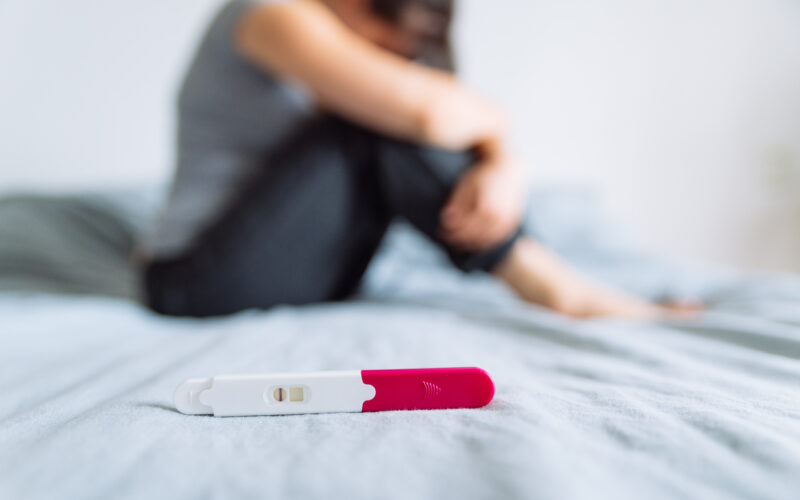“Three trips to the emergency room for morphine, two to urgent care for Toradol injections, eleven surgeries, monthly narcotics, nausea, vomiting, countless hours writhing in bedsheets, the tub, and/or the bathroom floor, dramatic diet changes, planning life around a period, and sometimes daily anti-inflammatories—for many women, the emotional pain of infertility is only one side of the coin.”
So reads one woman’s powerful story of nearly two decades of endometriosis and resultant infertility—and the abundant fruitfulness she found through, and even because of, it all. In Twelve Stripes Deep, Creighton Model FertilityCare practitioner and FAbM Base co-founder Mary Bruno writes that she first began experiencing abdominal pain at age 12 even before her first period. Over the course of the book, Bruno recounts the events and circumstances that led her to undergo twelve surgeries (hence the title) to address the effects of endometriosis inside her body, culminating in a hysterectomy at age 32 that definitively ended any hope of biological childbearing.
And yet, Bruno’s unflinching account—of the good alongside the bad, of lessons learned and growth achieved amidst deep physical and emotional pain, and the rollercoaster of uncertainty that is infertility—does not make for a depressing book. According to the book’s foreword, Bruno told her close friend and FAbM co-founder Emily that “I want to write a book for the woman who will never have a child, and let her know there is still hope.” Twelves Stripes Deep accomplishes that and more.
What’s the author’s background or credibility to teach on this topic?
Bruno writes primarily from personal experience and secondarily through the lens of her training as a Creighton Model FertilityCare practitioner. Throughout the book, she deftly interweaves accurate medical terminology, consistently explained in accessible language the average laywoman can easily grasp, with relatable and raw descriptions of her lived experience.
Who is the intended audience of Twelve Stripes Deep?
Bruno intended the book for women struggling with infertility, and these women will likely nod along knowingly as they read:
“Navigating the early seasons of consistently failing at getting pregnant was strange and embarrassing. You feel every possible symptom or unusual feeling, then google to confirm pregnancy. I have personally negatively identified all things from a head cold to a sore right calf (not even joking) to mean a baby was growing in my belly.”
Perhaps most especially she writes for those who, like her, desire deeply to conceive, but for whom biological childbearing becomes physically impossible. Certainly the book is likely to resonate most strongly with these two groups of women (those who can’t get pregnant now, but might in the future, and those who will never be able to), whom she points out frequently feel unseen and isolated, struggling silently on the receiving end of a steady stream of pregnancy announcements, Baptisms, birthday parties, and more, from extended family and friends.
Detailing as it does her experience working closely for years with medical professionals trained in restorative reproductive medicine, her book also deserves a read-through from reproductive healthcare providers determined to get answers for their patients faster than the current 10-year delay between symptom onset and the diagnosis of endometriosis.
What are the main content areas of Twelve Stripes Deep?
Bruno’s book is written as a memoir, more or less chronologically following her experience from her first period (mentioned briefly) to her final surgery roughly twenty years later. The bulk of the book takes place during the eight years when the majority of her surgeries took place. She covers the physical and emotional devastation endometriosis inflicts on the body, mind, and spirit, the particular impacts of its “evil stepsister” adenomyosis, her journey to discovering NaProTechnology, surgeries to address the root causes of her infertility, and her daughter Bella’s adoption story.
Strengths of Twelve Stripes Deep
I appreciated that Bruno calls out the lack of education and misinformation (from many sources) that deprives young women of necessary knowledge about their fertility and hormones, leading them to think, for example, that period pain is normal and “must be tolerated.” She notes:
“I didn’t know there was so much I didn’t know about my body as a young girl trying to navigate her way into adulthood. In a country that champions women empowerment, self-discovery, and ‘choice,’ where were my options? Where was the education about the incredible design of a woman’s body I so desperately needed?”
She decries the approach taken by medical providers to debilitating period pain, like the doctor she first went to who dismissively asked her “What kind of birth control do you want?,” instead of asking clarifying questions or conducting any kind of workup to investigate the cause of Bruno’s pain. Bruno clearly and succinctly explains why hormonal birth control is an inadequate treatment for endometriosis, and may in fact contribute to the lengthy delay (and disease progression) countless women experience between first symptoms and diagnosis. She asks poignantly: “How much less severe would the disease have become had I been actually diagnosed and treated by sixteen years old? eighteen years old? In less than twelve years??”
Later on, she continues:
“Had I been better educated and empowered by my doctors, schooling, my church, and/or my culture, learning how to read my body and understand what is normal and what is not, and been given access to a doctor like [NaProTechnology founder Dr. Thomas] Hilgers early in my teen years when it would’ve been most appropriate, how much more minimal would the damage have become? How much less pain would I have experienced? How many fewer days of school or work would I have missed? Would I be able to have children?”
She helpfully and gently shares the reasons behind her and her husband’s decision not to pursue artificial reproductive technologies like in vitro fertilization (IVF), which many Natural Womanhood readers may connect strongly with, even those who are not religious.
Bruno is also willing to “go there” in touching on topics that many women with endometriosis experience, like painful sex, and the emotional strain on a marriage when sex never leads to the desired baby.
She helpfully offers 15 practical suggestions for family and friends seeking to support women and couples struggling with infertility, and explains why well-meaning folks shouldn’t refer to NaProTechnology or other restorative reproductive medicine options as if they’re a “magic pill” that will cure all of a woman’s problems. It’s an especially transparent perspective, given that Bruno herself is “bought in” enough to the restorative reproductive medical approach to have become a trained Creighton Method instructor.
There’s much more that I liked about Twelve Stripes Deep, but my very favorite content was Bruno’s vulnerability about how accepting her infertility (which occurred gradually over time) led her to increasingly live out immense fruitfulness in other areas of her life.
Limitations or blind spots
I was unprepared for the front-and-center role that Bruno’s Catholic faith played in the book. Initially I was concerned that the ubiquitous references to Catholic teaching, beliefs and God might feel unrelatable and off-putting to readers of a different faith or no faith at all. But for Bruno, her faith was absolutely integral to her ability to come to a place of acceptance, to hope rather than despair, and to find healing and abundant fruitfulness. To scrub those references would have been to lose a core component of her experience. While the book is most relatable for Catholic readers, I believe that the book’s strengths, as described above, can speak to readers of any faith or no faith at all.
Bruno invites readers struggling with infertility to seek truly restorative reproductive healthcare and offers concrete resources (like her own FAbM Base website) to do so. Since many women lack in-depth knowledge of how fertility and hormones are supposed to work, let alone personal familiarity with their bodies’ own patterns of fertility (or lack thereof), Bruno herself provides this foundational education. Recognizing that most, if not all, women suffering from infertility will be offered IVF as a treatment, she offers a charitable, in-depth critique of the IVF process that enables other women to ask the hard questions about the physical and emotional toll IVF exacts, as well as its ethical implications.
The verdict: To buy, borrow, or skip Twelve Stripes Deep altogether?
I’d recommend borrowing or buying Twelve Stripes Deep. Women considering gifting a copy to a woman they know who struggles with infertility can check the book out ahead of time to judge for themselves whether their friend or family member is likely to appreciate it.
Additional Reading:
“Isn’t NaProTechnology just charting?” and other questions: A Natural Womanhood NaPro FAQ
“Is infertility treatable?” and other questions: A Natural Womanhood Infertility FAQ
8 ways endometriosis can make it more difficult to get pregnant







